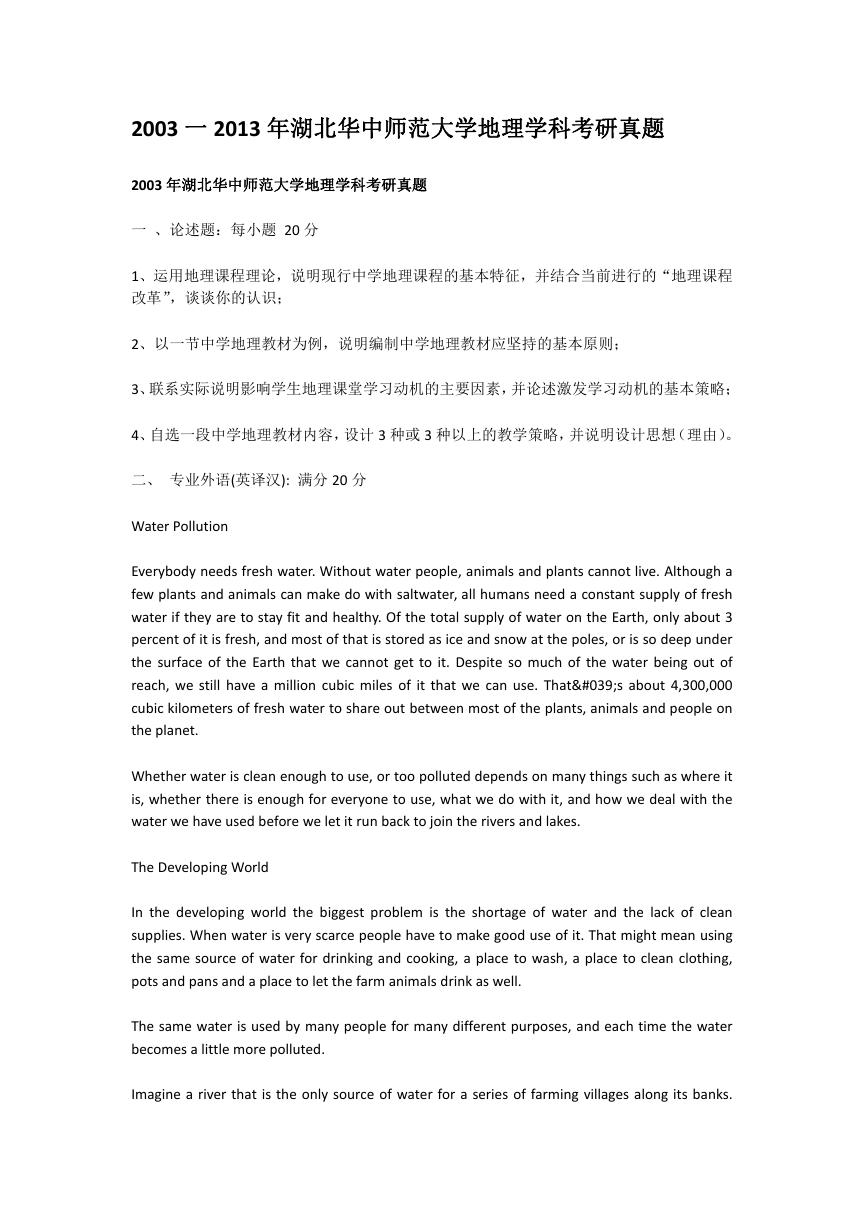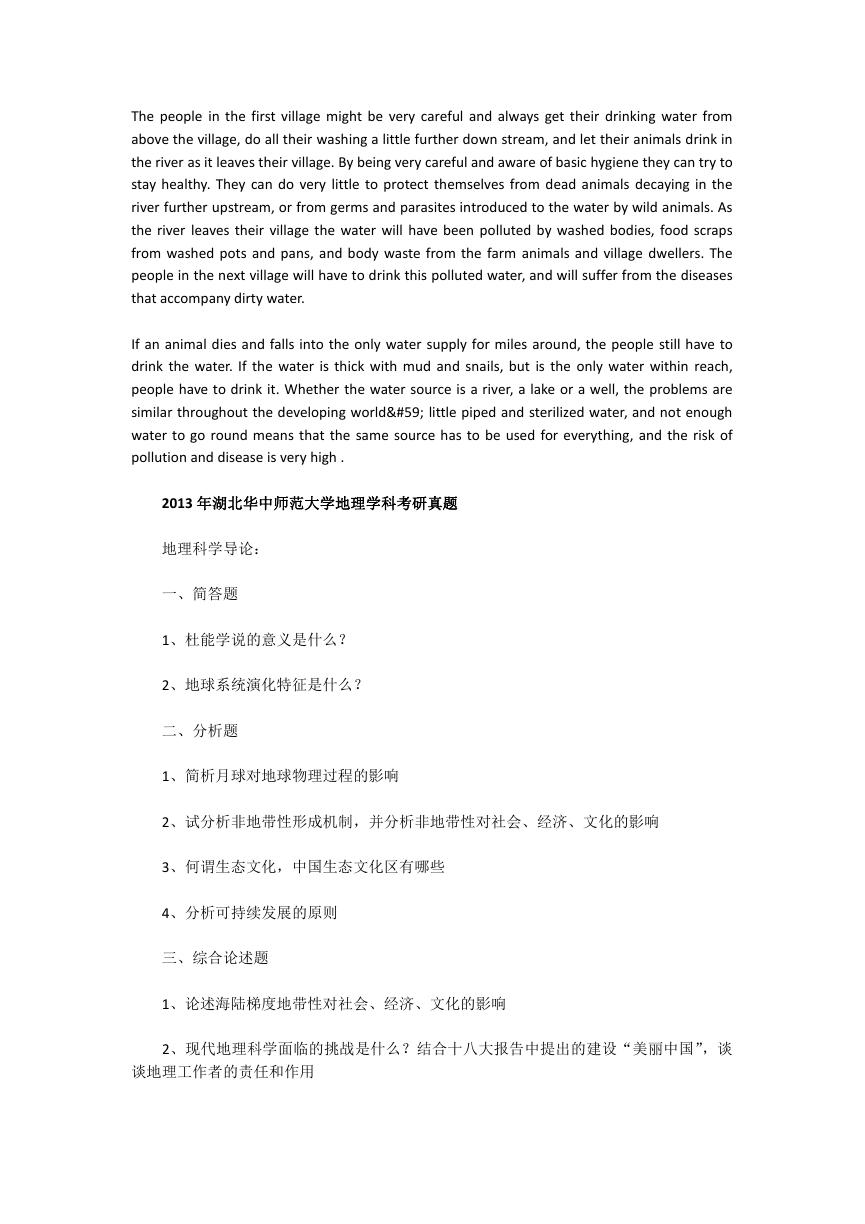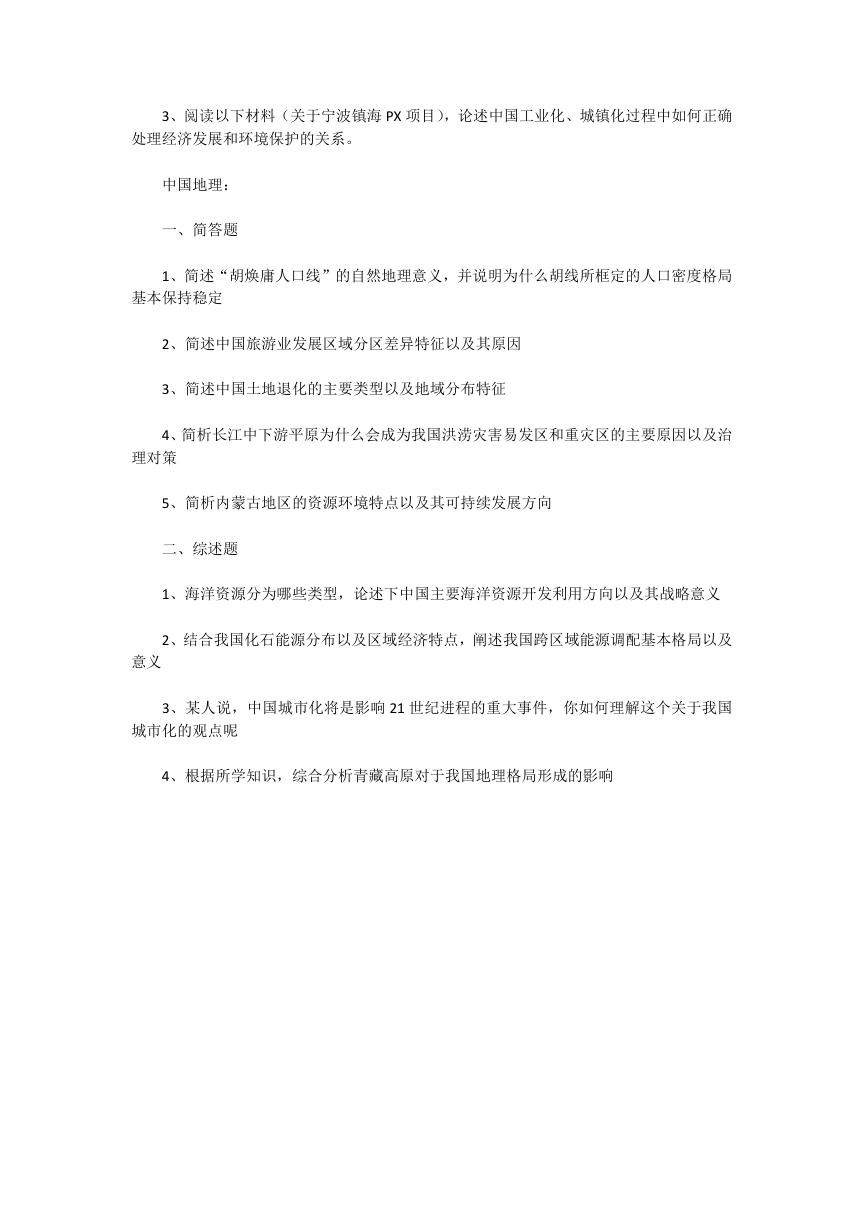2003 一 2013 年湖北华中师范大学地理学科考研真题
2003 年湖北华中师范大学地理学科考研真题
一 、论述题:每小题 20 分
1、运用地理课程理论,说明现行中学地理课程的基本特征,并结合当前进行的“地理课程
改革”,谈谈你的认识;
2、以一节中学地理教材为例,说明编制中学地理教材应坚持的基本原则;
3、联系实际说明影响学生地理课堂学习动机的主要因素,并论述激发学习动机的基本策略;
4、自选一段中学地理教材内容,设计 3 种或 3 种以上的教学策略,并说明设计思想(理由)。
二、 专业外语(英译汉): 满分 20 分
Water Pollution
Everybody needs fresh water. Without water people, animals and plants cannot live. Although a
few plants and animals can make do with saltwater, all humans need a constant supply of fresh
water if they are to stay fit and healthy. Of the total supply of water on the Earth, only about 3
percent of it is fresh, and most of that is stored as ice and snow at the poles, or is so deep under
the surface of the Earth that we cannot get to it. Despite so much of the water being out of
reach, we still have a million cubic miles of it that we can use. That's about 4,300,000
cubic kilometers of fresh water to share out between most of the plants, animals and people on
the planet.
Whether water is clean enough to use, or too polluted depends on many things such as where it
is, whether there is enough for everyone to use, what we do with it, and how we deal with the
water we have used before we let it run back to join the rivers and lakes.
The Developing World
In the developing world the biggest problem is the shortage of water and the lack of clean
supplies. When water is very scarce people have to make good use of it. That might mean using
the same source of water for drinking and cooking, a place to wash, a place to clean clothing,
pots and pans and a place to let the farm animals drink as well.
The same water is used by many people for many different purposes, and each time the water
becomes a little more polluted.
Imagine a river that is the only source of water for a series of farming villages along its banks.
�
The people in the first village might be very careful and always get their drinking water from
above the village, do all their washing a little further down stream, and let their animals drink in
the river as it leaves their village. By being very careful and aware of basic hygiene they can try to
stay healthy. They can do very little to protect themselves from dead animals decaying in the
river further upstream, or from germs and parasites introduced to the water by wild animals. As
the river leaves their village the water will have been polluted by washed bodies, food scraps
from washed pots and pans, and body waste from the farm animals and village dwellers. The
people in the next village will have to drink this polluted water, and will suffer from the diseases
that accompany dirty water.
If an animal dies and falls into the only water supply for miles around, the people still have to
drink the water. If the water is thick with mud and snails, but is the only water within reach,
people have to drink it. Whether the water source is a river, a lake or a well, the problems are
similar throughout the developing world; little piped and sterilized water, and not enough
water to go round means that the same source has to be used for everything, and the risk of
pollution and disease is very high .
2013 年湖北华中师范大学地理学科考研真题
地理科学导论:
一、简答题
1、杜能学说的意义是什么?
2、地球系统演化特征是什么?
二、分析题
1、简析月球对地球物理过程的影响
2、试分析非地带性形成机制,并分析非地带性对社会、经济、文化的影响
3、何谓生态文化,中国生态文化区有哪些
4、分析可持续发展的原则
三、综合论述题
1、论述海陆梯度地带性对社会、经济、文化的影响
2、现代地理科学面临的挑战是什么?结合十八大报告中提出的建设“美丽中国”,谈
谈地理工作者的责任和作用
�
3、阅读以下材料(关于宁波镇海 PX 项目),论述中国工业化、城镇化过程中如何正确
处理经济发展和环境保护的关系。
中国地理:
一、简答题
1、简述“胡焕庸人口线”的自然地理意义,并说明为什么胡线所框定的人口密度格局
基本保持稳定
2、简述中国旅游业发展区域分区差异特征以及其原因
3、简述中国土地退化的主要类型以及地域分布特征
4、简析长江中下游平原为什么会成为我国洪涝灾害易发区和重灾区的主要原因以及治
理对策
5、简析内蒙古地区的资源环境特点以及其可持续发展方向
二、综述题
1、海洋资源分为哪些类型,论述下中国主要海洋资源开发利用方向以及其战略意义
2、结合我国化石能源分布以及区域经济特点,阐述我国跨区域能源调配基本格局以及
意义
3、某人说,中国城市化将是影响 21 世纪进程的重大事件,你如何理解这个关于我国
城市化的观点呢
4、根据所学知识,综合分析青藏高原对于我国地理格局形成的影响
�






 2023年江西萍乡中考道德与法治真题及答案.doc
2023年江西萍乡中考道德与法治真题及答案.doc 2012年重庆南川中考生物真题及答案.doc
2012年重庆南川中考生物真题及答案.doc 2013年江西师范大学地理学综合及文艺理论基础考研真题.doc
2013年江西师范大学地理学综合及文艺理论基础考研真题.doc 2020年四川甘孜小升初语文真题及答案I卷.doc
2020年四川甘孜小升初语文真题及答案I卷.doc 2020年注册岩土工程师专业基础考试真题及答案.doc
2020年注册岩土工程师专业基础考试真题及答案.doc 2023-2024学年福建省厦门市九年级上学期数学月考试题及答案.doc
2023-2024学年福建省厦门市九年级上学期数学月考试题及答案.doc 2021-2022学年辽宁省沈阳市大东区九年级上学期语文期末试题及答案.doc
2021-2022学年辽宁省沈阳市大东区九年级上学期语文期末试题及答案.doc 2022-2023学年北京东城区初三第一学期物理期末试卷及答案.doc
2022-2023学年北京东城区初三第一学期物理期末试卷及答案.doc 2018上半年江西教师资格初中地理学科知识与教学能力真题及答案.doc
2018上半年江西教师资格初中地理学科知识与教学能力真题及答案.doc 2012年河北国家公务员申论考试真题及答案-省级.doc
2012年河北国家公务员申论考试真题及答案-省级.doc 2020-2021学年江苏省扬州市江都区邵樊片九年级上学期数学第一次质量检测试题及答案.doc
2020-2021学年江苏省扬州市江都区邵樊片九年级上学期数学第一次质量检测试题及答案.doc 2022下半年黑龙江教师资格证中学综合素质真题及答案.doc
2022下半年黑龙江教师资格证中学综合素质真题及答案.doc